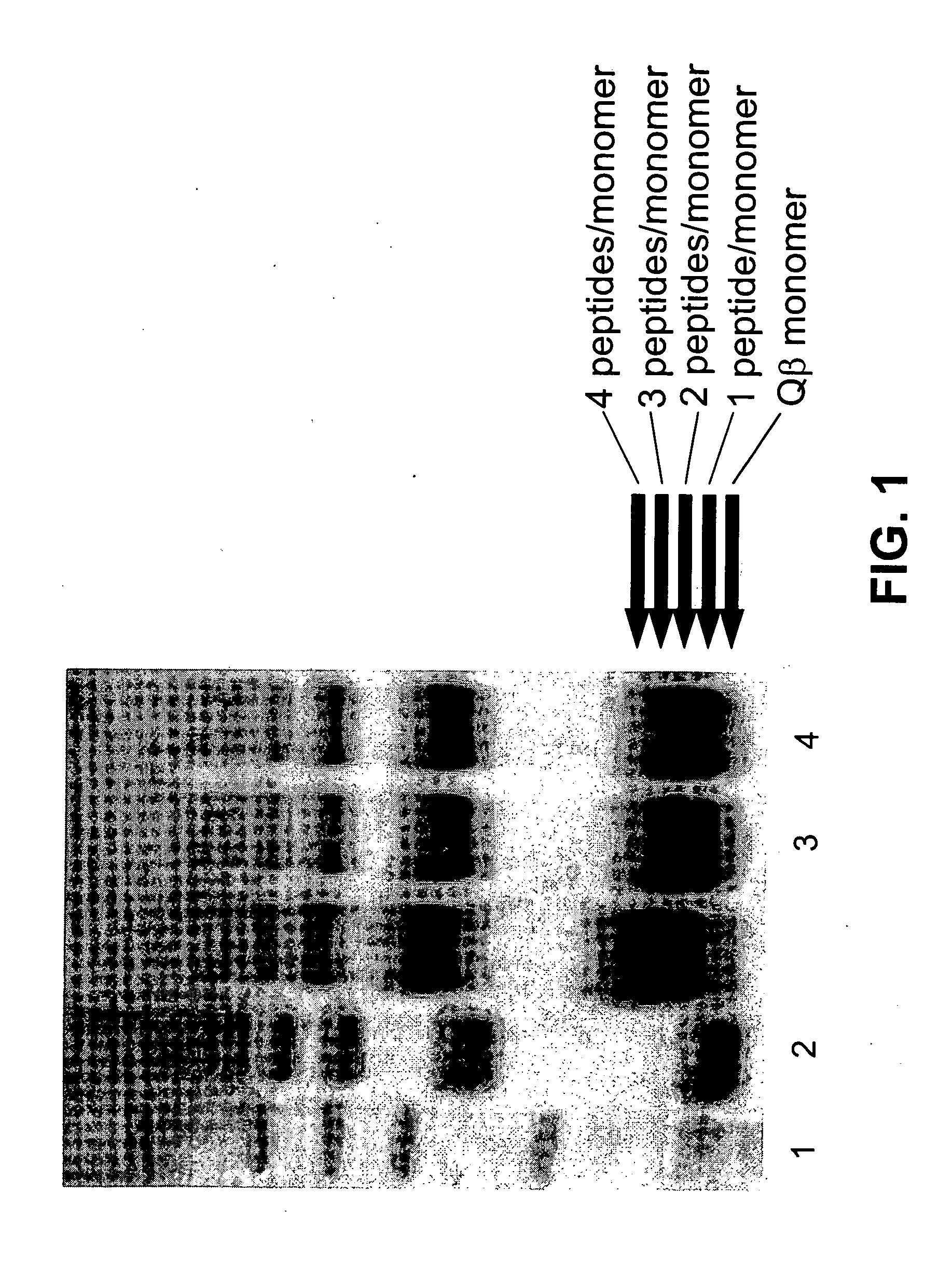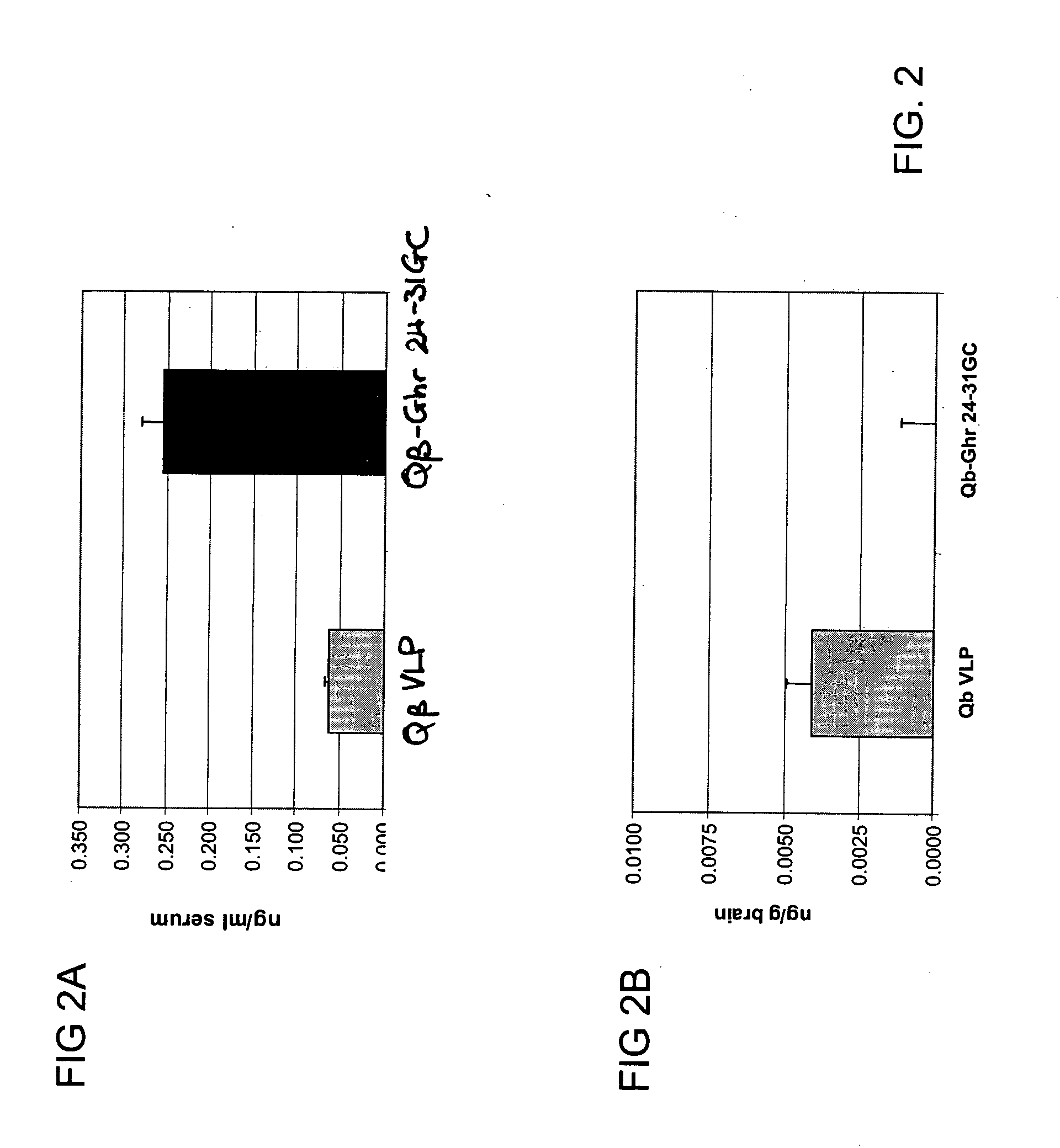Ghrelin-carrier conjugates
a ghrelin and carrier technology, applied in the field of molecular biology, virology, immunology and medicine, can solve the problems that peptides 10 aa may not induce antibodies that efficiently recognize native ghrelin, and achieve the effect of enhancing antigen absorption and increasing skin permeability
- Summary
- Abstract
- Description
- Claims
- Application Information
AI Technical Summary
Benefits of technology
Problems solved by technology
Method used
Image
Examples
example 1
Construction of HBcAg1-185-Lys
[0170] Hepatitis core Antigen (HBcAg) 1-185 was modified as described in Example 23 of WO 02 / 056905. A part of the c / e1 epitope (residues 72 to 88) region (Proline 79 and Alanine 80) was genetically replaced by the peptide Gly-Gly-Lys-Gly-Gly (SEQ ID NO:33), resulting in the HBcAg-Lys construct (SEQ ID NO:26). The introduced Lysine residue contains a reactive amino group in its side chain that can be used for intermolecular chemical crosslinking of HBcAg particles with any antigen containing a free cysteine group. PCR methods and conventional cloning techniques were used to prepare the HBcAg1-185-Lys gene.
[0171] The Gly-Gly-Lys-Gly-Gly sequence (SEQ ID NO:33) was inserted by amplifying two separate fragments of the HBcAg gene from pEco63, as described above in Example 23 of WO 02 / 056905 and subsequently fusing the two fragments by PCR to assemble the full length gene. The following PCR primer combinations were used:
fragment 1:Primer 1: EcoRIHBcAg(s)...
example 2
Fusion of a Peptide Epitope in the MIR Region of HbcAg
[0173] The residues 79 and 80 of HBcAg1-185 were substituted with the epitope CεH3 of sequence VNLTWSRASG (SEQ ID NO:60). The CεH3 sequence stems from the sequence of the third constant domain of the heavy chain of human IgE. The epitope was inserted in the HBcAg1-185 sequence using an assembly PCR method. In the first PCR step, the HBcAg1-185 gene originating from ATCC clone pEco63 and amplified with primers HBcAg-wt EcoRI fwd and HBcAg-wt Hind III rev was used as template in two separate reactions to amplify two fragments containing sequence elements coding for the CεH3 sequence. These two fragments were then assembled in a second PCR step, in an assembly PCR reaction.
[0174] Primer combinations in the first PCR step: CεH3fwd with HBcAg-wt Hind III rev, and HBcAg-wt EcoRI fwd with CεH3rev. In the assembly PCR reaction, the two fragments isolated in the first PCR step were first assembled during 3 PCR cycles without outer prime...
example 3
Fusion of the Ghrelin 24-31-Peptide Epitope in the MIR Region of HbcAg
[0176] The residues 79 and 80 of HBcAg1-185 are substituted with the ghrelin-peptide epitope of sequence: GSSFLSPE (SEQ ID NO:3). Two overlapping primers are designed using the same strategy described in Example 2, and the fusion protein constructed by assembly PCR. The PCR product is cloned in the pKK223.3 vector, and expressed in E. coli K802. The chimeric VLPs are expressed and purified as described in Example 24 of WO 02 / 056905.
PUM
| Property | Measurement | Unit |
|---|---|---|
| pH | aaaaa | aaaaa |
| concentration | aaaaa | aaaaa |
| volume | aaaaa | aaaaa |
Abstract
Description
Claims
Application Information
 Login to View More
Login to View More - R&D
- Intellectual Property
- Life Sciences
- Materials
- Tech Scout
- Unparalleled Data Quality
- Higher Quality Content
- 60% Fewer Hallucinations
Browse by: Latest US Patents, China's latest patents, Technical Efficacy Thesaurus, Application Domain, Technology Topic, Popular Technical Reports.
© 2025 PatSnap. All rights reserved.Legal|Privacy policy|Modern Slavery Act Transparency Statement|Sitemap|About US| Contact US: help@patsnap.com


